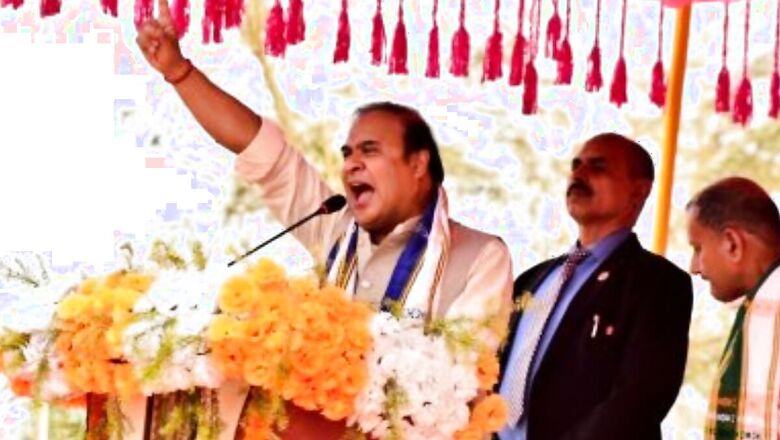
views
The recent arrest of five individuals from various locations in Assam, who are believed to have connections with Pakistan’s Inter-Services Intelligence and suspected involvement in terrorism, is a concerning development for Northeast India. This region is home to crucial military installations and is in close proximity to China and Bangladesh, which makes it particularly vulnerable. Therefore, it is crucial not to underestimate the potential threats faced by Northeast India, particularly Assam, which also has a constantly and fast-rising Muslim population.
As per news reports, the apprehended individuals have been recognised as Badruddin of Dhaniabheti Chalnabari near Batadrova Than, Baharul Islam of Moirabari Saruchala, Ashikul Islam of Juria, Wahiduz Jaman, and Mirjanur Rahman. The police recovered 136 sim cards, 28 mobile handsets, and some incriminating documents from their possession.
They were arrested for providing Indian mobile sim cards to Pakistan’s intelligence agency ISI.
In fact, Pakistan’s former ISI head Lt General Assad Durrani had once informed the Pakistan Supreme Court in 2013 about the spy agency’s interest in fuelling unrest in India’s Northeast. The fact that all the five arrested are members of the minority community and linked to the Muslim-dominated districts of Morigaon and Nagaon can’t be a mere coincidence. In March last year, Assam Chief Minister Himanta Biswa Sarma had said that Muslims account for 35 percent of the total population of the state and could no longer be called a minority community. The chief minister had also expressed concern that Assam was becoming a hotbed of Islamic fundamentalism.
Why it is worrying
In December 2007, the arrest of an ISI operative, who was also a member of Jamaat-e-Islami, Chhatra Shibir (of Bangladesh) and Harkat-ul-Mujahideen from Guwahati had sent shockwaves indicating the support ISI was providing to militant outfits in India’s Northeast. The Border Security Force (BSF) on many occasions stated that the ISI was actively coordinating with insurgents in the Northeast.
On December 24, 2022, CM Sarma informed the Assam Assembly that 53 suspected jihadis including one from Bangladesh have been arrested since March 2022. Sarma told the Assembly that places like Barpeta, Bongaigaon, Morigaon, Dhubri, Goalpara, Tamulpur and Nalbari had become “hubs of fundamentalist forces.” In October last year, the Assam Police arrested four individuals for alleged links with Bangladesh-based terror organisation Ansarullah Bangla Team and Al-Qaeda in the Indian subcontinent.
Sensitive military installations in Assam
The increasing incidence of silent terror activities by Islamic extremist groups, regardless of their affiliations, poses a significant threat to the national security of India. Assam is a strategically important state in Northeast India, having a number of military installations that play a crucial role in ensuring the security and stability of the region, particularly in light of the state’s proximity to neighbouring countries such as China, Bhutan and Bangladesh. Some of the significant military stations in Assam include Tezpur and Chabua Air Force Stations, which house Sukhoi squadrons, Kumbhirgram Air Force Station in Silchar, IV Corps and 51 Mountain Division in Tezpur, 2 Mountain Division at Dinjan in Dibrugarh district, 41 Artillery Brigade at Narangi in Guwahati, and Missamari military station, which is home to the Light Combat Helicopter Prachand.
Uncertainty at LAC
Last December, the unstable situation along the Line of Actual Control (LAC) in the Eastern sector of Arunachal Pradesh was once again brought to the forefront due to a clash between Indian and Chinese troops near Yangtse in the Tawang sector. The Indian Army released a statement – “On December 9, PLA troops contacted the LAC in Tawang sector which was contested by own (Indian) troops in a firm and resolute manner. This face-off led to minor injuries to few personnel from both sides. Both sides immediately disengaged from the area. As a follow up of the incident, (Indian) commander in the area held a flag meeting with his counterpart to discuss the issue in accordance with structured mechanisms to restore peace and tranquillity. In certain areas along the LAC in the Tawang sector, there are areas of differing perception, wherein both sides patrol the area up to their claim lines. This has been the trend since 2006.”
The mention of “areas of differing perception” in the military note holds great importance as they represent vulnerable points where further skirmishes may occur. In fact, tensions had also escalated between the troops of both nations in October last year, which was resolved locally without the use of force.
The precarious situation along the LAC is evident from the fact that in February, US Senators Jeff Markley and Bill Haggerty, along with co-sponsor John Cornyn, introduced a resolution in the Senate reaffirming the state of Arunachal Pradesh as an “integral part of India” and expressing support for India’s “sovereignty and territorial integrity.” The resolution also denounced China for its “use of military force” to alter the status quo at the LAC.
It is no secret that the intelligence-sharing agreement between Pakistan and China has only strengthened over time. Any intelligence collected by the ISI in Assam or the entire Northeast region will undoubtedly be shared with China, given Beijing’s clear expansionist intentions, no matter how much it tries to conceal them. Geographically isolated from the Indian mainland and facing dual threats from an aggressive foreign military, on its northern borders, and growing internal dangers posed by covert jihadi operations aided by the ISI, India’s Northeast finds itself at a crossroads in addressing a grave existential crisis.
The hidden agenda of ISI
That the aim of the ISI is beyond the military is quite obvious.
“Assam is geographically far away from Pakistan, but the ISI is still trying to find loopholes to exploit it. They are undoubtedly gathering a database of people who are anti-Hindu or are uncomfortable calling themselves Hindus. They are also quietly scanning for black sheep among nationalists who can be used for their agenda. Transferring funds through hawala is already happening. The ISI is undoubtedly trying to create an atmosphere of civil disobedience. The protest against the Citizenship Amendment Act (CAA) is an obvious example. Why are there so many protests? The only attempt is to weaken nationalism,” said Raktim Patar, assistant professor in History from Gargaon College in Assam.
The concerning issue is that the ISI is extending its reach to all possible areas in Assam, and individuals with Jihadist inclinations are readily providing the foreign intelligence agency with opportunities.
“They are definitely hiding in various nooks and corners of Assam, assuming various disguises and identities. Whatever arrests were made recently is just the tip of the iceberg. Although at face value, there is a difference between an ISI agent and a Jihadi fundamentalist, in reality, they are directly connected. Only a Jihadi will share sensitive information with a foreign espionage agency like ISI. It is offering a platform to those with a Jihadi mindset in Assam. ISI is not for direct conflict but seeking to make Assam and the entire Northeast India a terror-hit region by trying to terrorise organizations like the Jaish-e-Mohammad or the Lashkar-e-Taiba just like in the Kashmir Valley. They are financing, motivating vulnerable minds, and distributing Jihadi literature to fuel this whole mission,” the college professor said.
For centuries, efforts to Islamise Northeast India have persisted, with Assam offering a convenient entry point, given its burgeoning Muslim population of disputed heritage. The ISI is seeking to capitalise on this ongoing trend by any means possible. The proximity of Assam to Bangladesh presents the ISI with a prime opportunity to further its malevolent agenda.
“The roots of Islamic fundamentalists in Assam are very deep. Attempts to Islamise the Brahmaputra Valley have been ongoing since the 13th century and this is part of a larger agenda. Until 1681, they consistently tried, after which direct invasions stopped, but silent ones always continued. Blaming the British is only an excuse. Their aim is to Islamise Southeast Asia, and the attempt is still ongoing. All anti-India forces are part of it because, if you notice, those who are caught are not Pakistanis but Pakistani agents. Their aim is to create Jihadis here. These people are trying to create a Jihadi base in Assam,” the history professor said.
What is sad and alarming is a section of politicians are completely backing this fundamentalist outlook by overt and covert means.
“There are a set of politicians who will put the blame on the eviction of those occupying government lands illegally, which led to the fuelling of Jihadi mindsets. This is nothing but an eyewash. Gaining political advantage is also a hidden agenda for purposes like protecting Jihadis, protecting illegal occupants of the land, and thwarting attempts to control population explosion among the largest religious minority. They are trying to create a platform for deliberate denial so that rampant Islamisation continues. Serious verification is needed from documents to SIM cardholders or else consequences will be severe if we cannot stem it immediately. It is a dual threat to our culture and country,” said Patar.
A grim reality
The apprehension of ISI agents by Indian agencies is a clear indication of their resolute efforts to combat the challenge at hand. However, it’s disheartening to note that this is a covert battle with no immediate end in sight at least for now.
The author is Deputy Editor, General News, Firstpost. Views expressed are personal.
Read all the Latest Opinions here



















Comments
0 comment